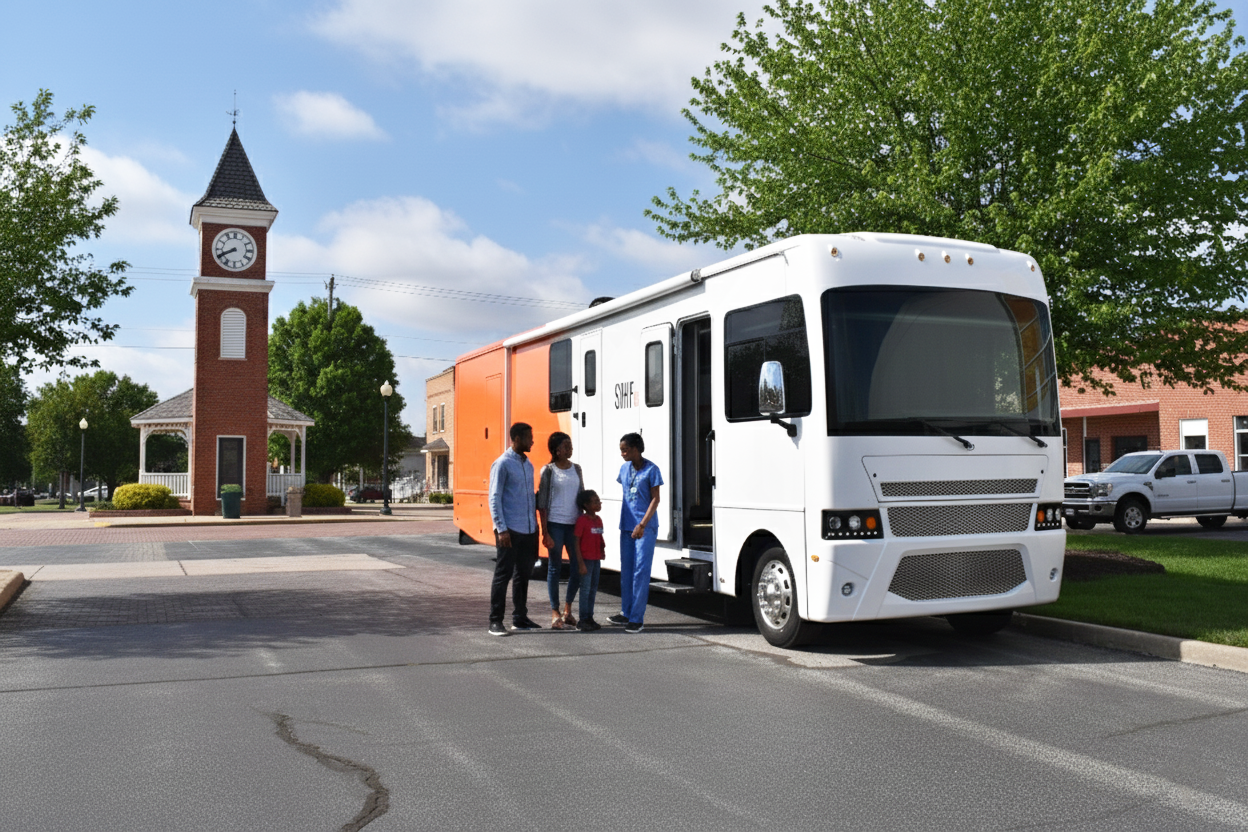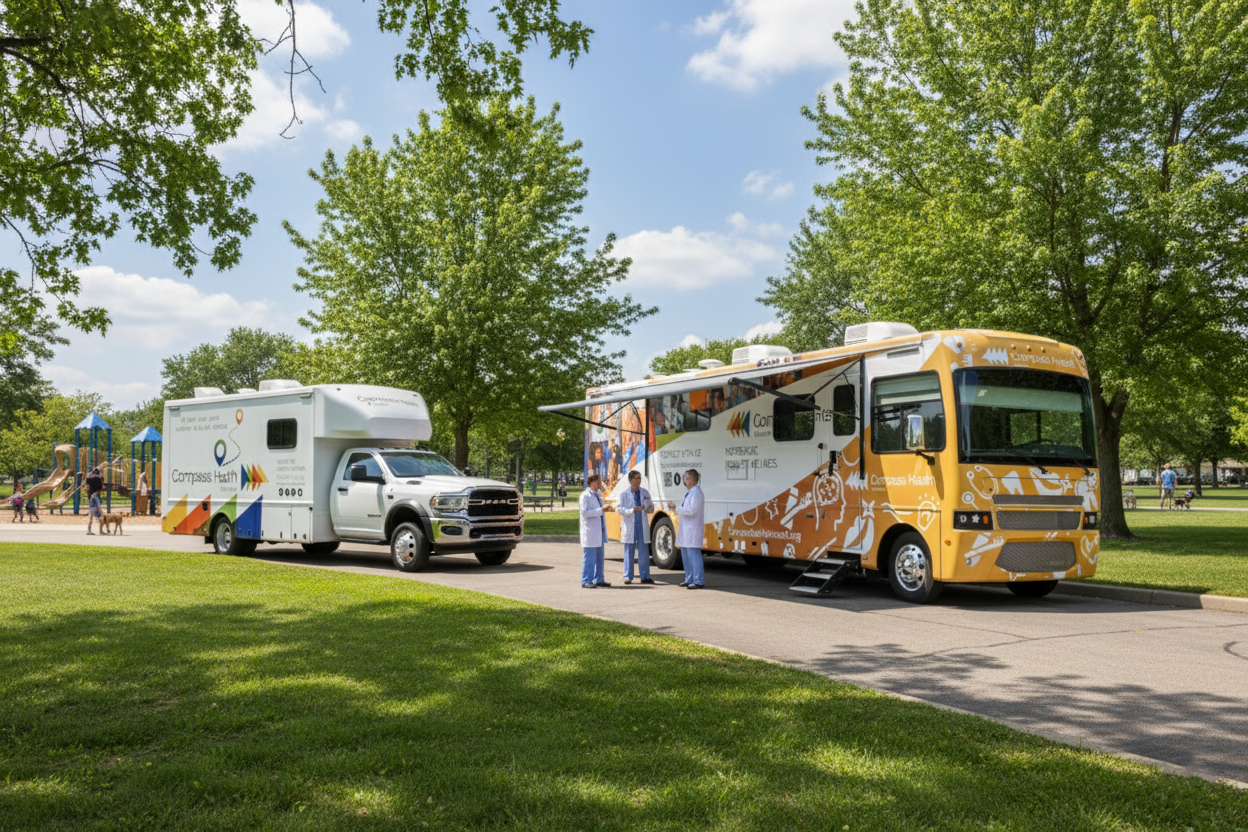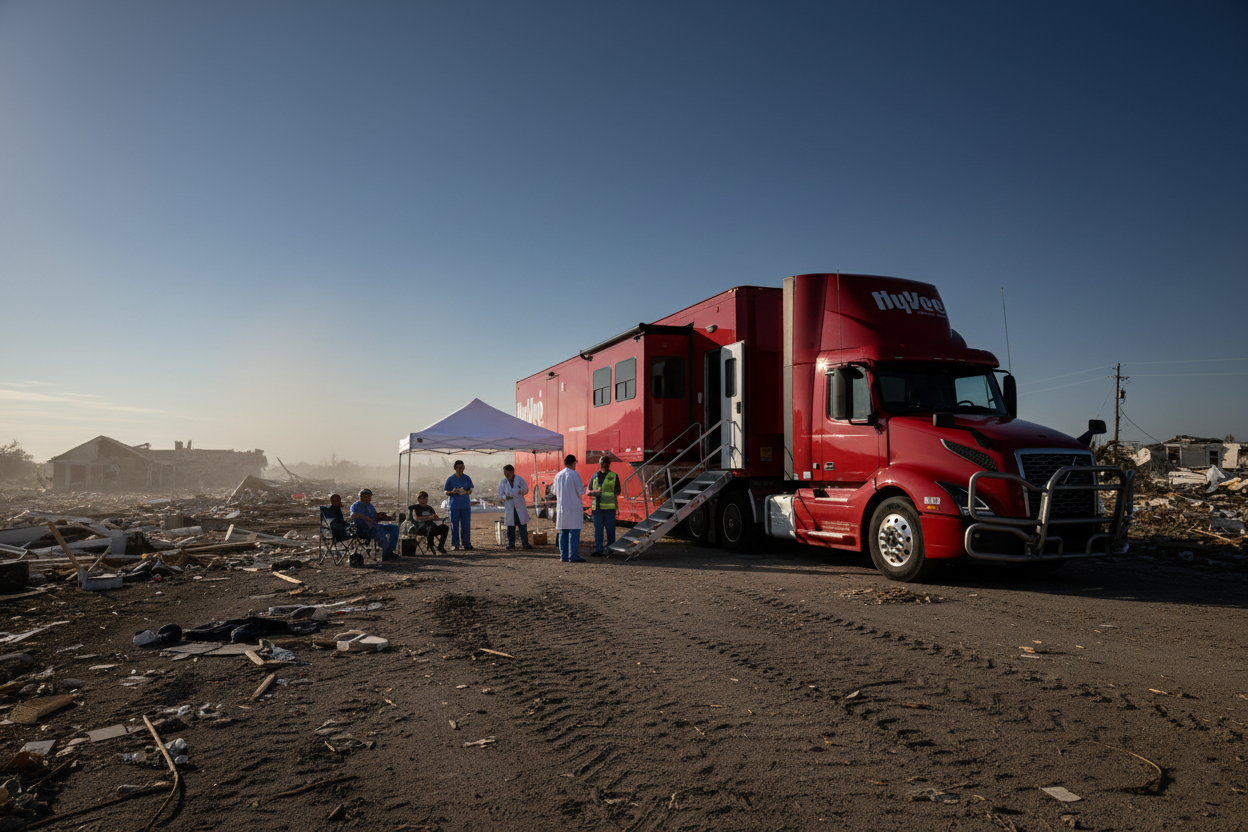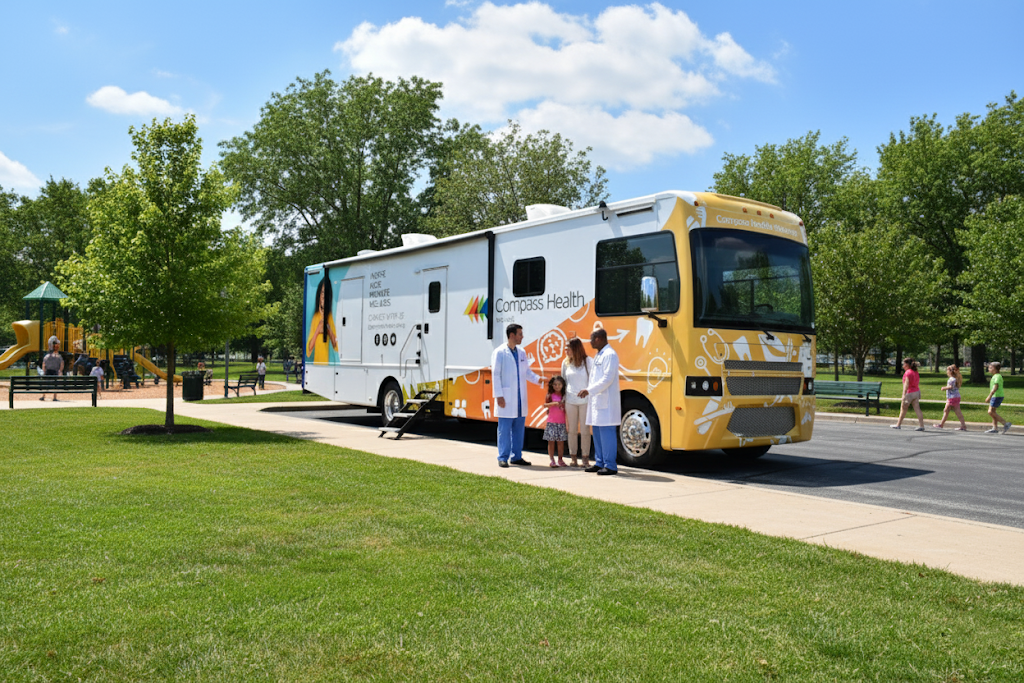Medical Trailers vs. Medical Vans: Why Trailers Are Better
Access to quality healthcare is not evenly distributed, and mobile medical solutions have stepped in to bridge the gap. A medical trailer is a large,...
9 min read
Craftsmen Industries Oct 20, 2025 6:09:10 AM

Mobile medical RVs are large, fully equipped healthcare vehicles that are significantly larger and more advanced than standard vans. Built on bus or motorhome platforms, they can host exam rooms, diagnostic labs, and telehealth technology, making them true mobile clinics. They aim to deliver hospital-level care to rural, underserved, or disaster-hit areas with limited access.
The rise of telemedicine has accelerated its importance. Fortune Business Insights reports that the global telehealth market is projected to grow from USD 186.41 billion in 2025 to USD 791.04 billion by 2032, at a compound annual growth rate (CAGR) of 22.9 %
In this article, we’ll explore how telemedicine integration, digital diagnostics, and AI-powered tools are reshaping the future of RV-based healthcare, making treatment more accessible, efficient, and patient-centered.
Mobile medical RVs are self-contained, large-scale vehicles designed as mobile clinics. Unlike standard vans or towable trailers, these RVs are purpose-built on motorhome or bus-sized platforms, allowing them to host complete medical facilities on wheels.
Here’s how they differ from other mobile healthcare formats:
Due to their space, autonomy, and versatility, RVs are often chosen by healthcare providers when they want to deliver comprehensive services in a single visit. They can handle diverse needs, including preventive screenings, chronic disease management, mobile dental services, and real-time telemedicine consultations, all under one roof.
This adaptability makes them especially valuable in rural regions, underserved urban neighborhoods, and emergency response scenarios, where setting up a full-scale clinic is not feasible.
Mobile medical RVs become significantly more impactful when powered by advanced technology. These vehicles are not just mobile clinics, but connected care hubs that enhance patient and provider outcomes. Technology enhances mobile healthcare in several key ways:
The shift toward telemedicine adoption supports this transformation. Patients and providers are increasingly comfortable with virtual care, making it a natural next step to integrate telehealth into mobile medical RVs. Instead of traveling to major hospitals, patients can walk into an RV, receive exams or tests, and connect to specialists via secure telehealth platforms.
Telemedicine is no longer an optional add-on in mobile healthcare; it has become the backbone of modern mobile medical RVs. These vehicles are engineered to support telehealth systems, transforming them into highly connected care hubs that deliver physical treatment and digital access to specialists and remote providers.

Unlike traditional mobile clinics that relied heavily on in-person consultations, new RV designs integrate:
These upgrades mean patients in remote towns, migrant communities, or disaster zones can access the same specialty care as those in major hospitals.
According to Precedence Research, the global telehealth market is projected to grow from USD 196.81 billion in 2025 to approximately USD 1.21 trillion by 2034, reflecting a compound annual growth rate (CAGR) of 22.55%. This dramatic expansion underscores the growing alignment of healthcare-on-wheels with the momentum of global healthcare delivery.
Teleconsultation within medical RVs significantly expands the reach of healthcare. Patients no longer need to travel hours for specialist visits. Instead, they can walk into an RV clinic and connect instantly. These capabilities include:
According to the U.S. Department of Health and Human Services (HHS), telehealth visits among Medicare fee-for-service beneficiaries surged 63-fold in 2020 compared to 2019, jumping from approximately 840,000 visits to 52.7 million. This rapid adoption helped establish new care habits, particularly among rural residents and older adults, the groups that mobile RV clinics often serve.
Seamless integration of electronic health records (EHRs) is crucial to the functionality of mobile RVs. Providers inside these clinics need the same access to data as hospital staff. Advanced EHR systems in RVs allow:
According to the U.S. Department of Health and Human Services’ Office of the National Coordinator for Health IT (ONC), 96 percent of non-federal acute care hospitals had implemented a certified electronic health record (EHR) system by 202. Equipping RVs with this infrastructure will provide patients with the same continuity of care on the road as they would in a traditional hospital.
The most transformative telehealth feature in RVs is remote diagnostics. These clinics carry portable devices and wearables that allow real-time monitoring and analysis:

Modern medical RVs go far beyond teleconsultation. They are fitted with advanced diagnostic and connectivity technologies, making them nearly equivalent to compact hospitals. This makes them especially valuable for outreach programs, disaster relief, and serving remote regions with limited healthcare infrastructure.
In the past, imaging was rarely possible in mobile healthcare. Today, RVs integrate portable imaging and lab systems, including:
These capabilities enable the quick diagnosis of critical conditions, saving precious time in emergencies.
AI systems are increasingly integrated into mobile RVs, providing decision support to frontline staff. Benefits include:
Connectivity is the lifeline of telemedicine. Without fast, stable networks, even the most advanced RVs cannot function effectively. Many units are now built with 5G antennas and satellite backup systems.
5G networks deliver speeds up to 20 Gbps, allowing instant transmission of medical imaging files. Real-world studies show that 5G can reduce data transfer latency to under 10 milliseconds, compared to 50 milliseconds or more with 4 G.
This performance enables a CT scan taken in a mobile RV to be sent to a radiologist in seconds, allowing for rapid diagnosis even from hundreds of miles away. In rural America, where 19% of the population still lacks reliable broadband access, 5G-enabled RVs close critical digital divides.
Mobile medical RVs with telehealth systems improve patient and provider outcomes. Combining in-person care with virtual technology expands reach, reduces delays, and lowers costs.

Here are some patient benefits given below:
Here are some provider benefits given below:
Despite their promise, mobile RVs face challenges that require careful planning. Connectivity, cost, workforce training, and compliance remain the most significant hurdles.
The following are the challenges:
Here is a quick breakdown:
Here is a quick breakdown:
The following are the challenges:
Over the next 5–10 years, medical RVs are expected to shift from being just mobile clinics to becoming intelligent, flexible, and highly connected healthcare hubs. Advances in artificial intelligence, robotics, modular design, and hybrid trailer-RV systems will transform the delivery of care in underserved regions.
One of the most significant shifts will be the rise of AI-powered care. AI tools already support diagnostics, but future mobile clinics will use predictive analytics to identify health risks earlier and guide treatment plans more accurately. According to the National Institutes of Health (NIH), AI in healthcare is projected to expand rapidly, helping providers improve outcomes while reducing diagnostic errors.
Alongside AI, robotics and automation will play a key role. Hospitals increasingly use robots for logistics and patient support, and similar systems are expected to be adapted for mobile settings. Studies show that nursing and telepresence robots can effectively handle tasks such as monitoring vital signs, transporting supplies, and facilitating remote consultations in areas where clinicians are scarce.
Finally, hybrid trailer-RV systems will enhance scalability. By combining RVs’ mobility with detachable trailers, providers can deploy larger facilities during emergencies or high-demand situations. According to Dimension Market Research, the global mobile clinics market was valued at approximately USD 5.5 billion in 2024 and is projected to expand to USD 15.3 billion by 2033, reflecting a 12% CAGR. This underscores the accelerating global shift toward mobile healthcare delivery.
A medical RV is a self-contained vehicle that can be driven directly to a location, making it highly mobile and easily deployable. It typically includes built-in exam rooms, telemedicine systems, and diagnostic equipment, making it suitable for smaller-scale but flexible healthcare delivery.
Yes, modern medical RVs are designed to support telehealth fully. They are often equipped with high-definition video systems for virtual consultations, digital diagnostic devices for patient monitoring, and integrated electronic health record systems that allow providers to securely access and update patient data.
The cost of building a telemedicine-enabled RV depends on the level of customization and the type of technology used. A smaller unit with basic telehealth capabilities generally costs around $300,000, while a fully outfitted RV with advanced imaging tools, laboratory facilities, and satellite connectivity can cost closer to $1 million. These costs also vary by region, compliance requirements, and the scope of services the RV is designed to deliver.
Yes, internet connectivity is essential for RVs that support telemedicine. Video consultations, EHR access, and remote diagnostics depend on strong data connections. Most RVs rely on 5G networks, where available, while Wi-Fi hotspots are used in semi-urban areas. In very remote regions, satellite internet becomes the primary solution.
Telemedicine-enabled RVs are built to meet HIPAA standards for patient privacy and data security. This is achieved through secure electronic health record systems, encrypted video communications, and controlled access to sensitive information.
Specialties combining technology and care, such as telemedicine, AI-driven diagnostics, genomics, and geriatrics, are experiencing the strongest growth due to aging populations and digital health adoption.
NEMT demand will rise with aging populations and chronic disease management, enhanced by ride-sharing integrations, telehealth coordination, and AI-powered scheduling to reduce costs and delays.
Looking ahead, several long-term trends are expected to shape healthcare over the next decade:
Telemedicine and advanced technologies are reshaping how healthcare reaches patients, and mobile medical RVs stand at the center of this transformation. These units are bridging care gaps in rural and underserved communities by integrating secure EHR systems, AI-assisted diagnostics, and reliable 5G or satellite connectivity. Patients benefit from faster diagnoses, better outcomes, and easier access to specialists, while providers gain efficiency and expanded reach.
At Craftsmen Industries, Inc., we specialize in designing and building fully customized solutions that align with these technological advancements. Whether you’re seeking Medical Trailers for large-scale operations or exploring Technology Integration in Mobile Healthcare to bring cutting-edge tools on the road, our expertise ensures you are equipped for the future of patient care. Learn more about our Medical Trailers and Technology Integration in Mobile Healthcare.

Access to quality healthcare is not evenly distributed, and mobile medical solutions have stepped in to bridge the gap. A medical trailer is a large,...

Medical vehicles, including purpose-built trailers, mobile clinics in RVs, and heavy-duty trucks (excluding vans), are transforming healthcare...

Mobile medical vehicles are moving clinics built into trailers, RVs, or trucks (not vans). Think of them as hospitals on wheels that bring care...